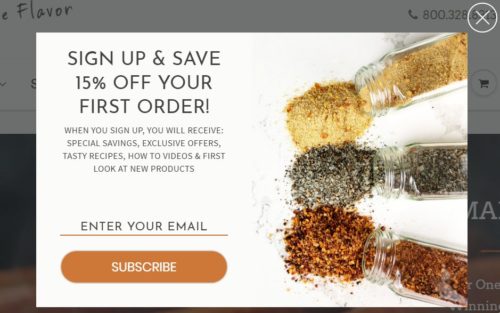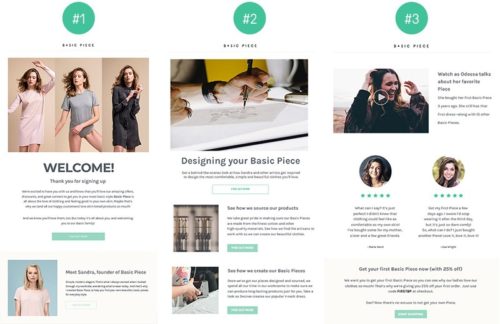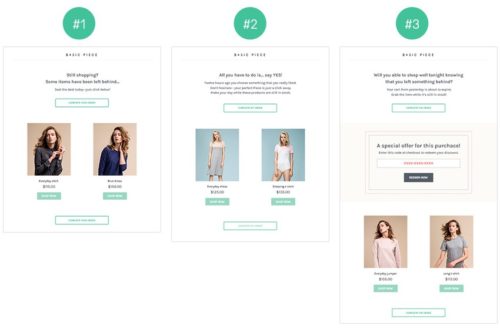
The real money is in emails. For every single dollar you spend on email marketing, it brings an ROI of $44. To this day, regardless of all the breakthroughs and innovations that shook the marketing landscape, email is still the most effective channel to reach customers directly and drive sales.
However, if it was that easy, wouldn’t everyone be nailing their email strategy? Good point. The secret to really successful email marketing campaigns lies in these five simple steps.
STEP 1. Develop a relationship with potential customers
The reason why content marketing has become the number one strategy for all online businesses is that it helps brands earn customers’ trust and gently guide them through the buying journey.
The fact that 97% of visitors abandon their shopping carts is a clear sign of a lack of trust.
To overcome that challenge, you need to start collecting visitor emails and nurturing those relationships through the following steps:
- Staying top of mind by serving ads to your visitors online – Instagram, Facebook, Google ads, etc.
- Keeping in touch via email with relevant offers: Black Friday discounts, Christmas sales, new collections, etc.
- Automating your marketing: abandoned cart emails, reminders, personalized content, etc.
A consistent approach to prospect nurturing is a reliable and effective way to establish trust and increase conversions.
STEP 2. Implement list-building techniques that fit your business
Buying an email list is unethical and often illegal. Plus, people hate cold emails, so don’t even think about going down that route.
For your email marketing efforts to pay off, you’ll need to build your own email list of high-quality email recipients. They could be your site visitors, social media followers or content consumers – here are a few ideas on how you can go about collecting emails.
- Use popups, they work.
We’ve learnt through numerous experiments that the best-performing popups are those that offer something valuable in return for the visitor’s email address. It will depend on your audience whether that’s a discount on the first purchase, free shipping or high-quality content.
You should also think about the circumstances in which you want the popup to appear. For example, will that be immediately after the visitor lands on your site, when they navigate to a particular page or when they’re about to abandon your store?
Our experience shows that the exit-intent popup has the best success rate (35% conversions) as well as offers the best user experience.
Take a look at an excellent example below that combines a great image, killer copy, and an appealing offer.

- Experiment with interactive signup forms
Gamifying popups is a neat idea – who doesn’t love a good game?
The biggest advantages associated with interactive signup forms are:
- They’re fun
- They reward visitors instantly, encouraging them to spend right away
- They generate up to three times more signups
At Omnisend, we offer Spin a Sale, Wheelio and Wheel of Fortune interactive signup forms that streamline list-building efforts. Try one and start collecting emails immediately!
STEP 3. Automate your emails
At Omnisend, we recommend you set up automated email workflows immediately after you implement list-building practices.
This will help you ensure that your customers get the right message at the right time. Plus, once set up, they require very little upkeep. You can go in and change them at any point, but until then, they’re doing the hard work for you – engaging your customers and driving up sales.
Here are the most important types of automatic emails to consider.
- Welcome emails
A welcome email is something that you send to new subscribers. However, we’ve found that three emails are actually the most effective for welcoming your new subscribers. If you opt to send three emails instead of one, you can get 3x higher open and click rates—as well as 5x higher revenue.
See the example of three welcome emails below:

- Abandoned cart emails
Like with the welcome series, we recommend sending three automated abandoned cart emails instead of just one. Why? Because they generate a staggering 1.8% conversion rate and are 20 times more effective than a single newsletter.
These emails are triggered when shoppers leave your site without buying the items they added to their cart.
Honesty is the best policy with this type of emails:
- Include images of the abandoned products
- Use conversational language in the subject line, for example, “Did you forget something?” or “Still shopping?”
- A prominent CTA that takes shoppers straight to the shopping cart
Here’s a quick example:

Other automated emails could include a birthday message, a customer winback email, shipping update or order confirmation. These emails give you a reason to reappear in customer’s inbox with valuable information.
STEP 4. Start sending effective emails
Now that we’ve covered list-building and automated emails, let’s look at what makes the perfect email campaign.
Word of caution, though: if you’re not sending automated emails and this is your first-ever email campaign, make sure you introduce your brand, the purpose of the email and how often you’re planning to reach out to your customers in the future.
We suggest sticking to just one or two emails a month at first and reassessing the situation once you have some more data.
And last but not least, think about email design. It cannot be stressed enough how important design is in email marketing.
Here are our top tips:
- Less is more: select and feature 5-7 products and keep the email uncluttered.
- Use mobile-friendly designs. Always test your campaigns before hitting the send button.
- Clearly define where one section of email ends and another begins. Make it scannable.
- Use only high-quality product images.
- Limit the number of CTAs and make them stand out.
Kali Laine has improved their email click rate by 118% by stripping their email design to bare basics.
STEP 5. Try multichannel campaigns
Want to take your email marketing a notch higher? Try combining a few different channels.
For instance, if you start using popups to collect customer data, such as their birthday and phone number, you could add SMS/messages to your strategy.
You could send a text first and then follow up with an email (see a great example below). Needless to say, it’s a powerful combo!
In the world of email, Mailchimp is the king. But if you’re looking for a less expensive, eCommerce-oriented tool, Ominisend is a great Mailchimp alternative. It’s a good idea to spend a bit of time researching your options, because, with the right automation tools and a few proven tactics, your email marketing can quickly become your best performing marketing channel.






